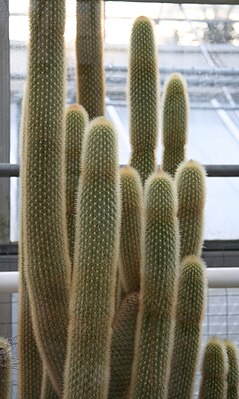Haageocereus fascicularis
| Haageocereus fascicularis | ||||||||||||
|---|---|---|---|---|---|---|---|---|---|---|---|---|

Haageocereus fascicularis |
||||||||||||
| Systematics | ||||||||||||
|
||||||||||||
| Scientific name | ||||||||||||
| Haageocereus fascicularis | ||||||||||||
| ( Meyen ) F. Knight |
Haageocereus fascicularis is a species of plant in the genus Haageocereus from the cactus family(Cactaceae). The specific epithet fascicularis means 'bundle-like, tuft-like'.
description
Haageocereus fascicularis has a shrubby growth with ascending to upright, gray-green shoots that branch from the base and reach a length of 0.5 to 1 meter with a diameter of 4 to 7 centimeters. There are eleven to eighteen blunt ribs . The one to two straight central spines are 4 to 15 centimeters long. The seven to ten splaying radial spines have a length of 1 to 4 centimeters.
The white, strongly scented flowers reach a length of 7 to 8.5 centimeters. Your pericarpel and the flower tube are covered with hair and reddish scales. The egg-shaped fruits are bright red.
Distribution and systematics
Haageocereus fascicularis is common in Chile from Arica to Tarapacá .
It was first described as Cereus fascicularis in 1833 by Franz Julius Ferdinand Meyen . Friedrich Ritter placed the species in the genus Haageocereus in 1980 . Synonyms are Echinocactus fascicularis (Meyen) Steud. (1840), Trichocereus fascicularis (Meyen) Britton & Rose (1920), Weberbauerocereus fascicularis (Meyen) Backeb. (1941) and Cactus fascicularis Meyen (1834).
proof
literature
- Edward F. Anderson : The Great Cactus Lexicon . Eugen Ulmer KG, Stuttgart 2005, ISBN 3-8001-4573-1 , p. 333 .
Individual evidence
- ↑ General garden newspaper . Volume 1, 1833, p. 211, (online) .
- ↑ Cacti in South America: Results of my 20 years of field research . Volume 3, 1980, pp. 1125-1126.